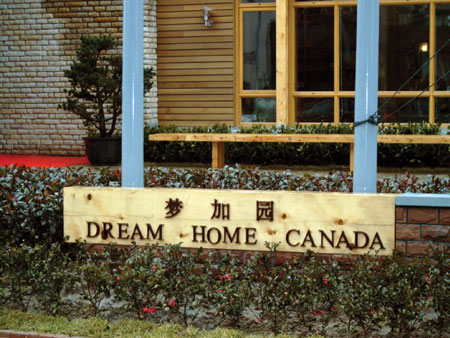
Creating a market for wood housing in China
|
Dr. de la Roche says that Canada’s brand should stand for certified wood and the knowledge to help other countries build high-quality platform-frame structures. “Finland has been branding for years and there’s no reason to think that Canada cannot do the same.” In fact, Canada has been working hard to create a market for its structural lumber in housing and to sell higher-value products in China instead of simple raw fibre.
Timber-frame construction in China spans several centuries. However, concrete and mortar have evolved to become the building materials of choice. “Wood has typically been associated with inexpensive housing in China’s rural areas, but as the Chinese have moved around the world they have seen luxurious wood houses. Now, as expatriates return to China, they bring with them this new view of things, which creates a potential market for Canadian structural wood,” says Dr. de la Roche.
Canada identified China as a potential market for platform-frame construction in the early 1990s. In 1996, it established formal relationships and exchange programs with several Chinese academic and research organizations. “Through these relationships, Canadians joined a working group that was looking to establish Western-style wood building codes in China. This group’s work has paid off as new building and fire codes are now in place.”
Dr. de la Roche adds that once the codes were in place, the next step was to create a demand for wood houses. To do so, he says, “the British Columbia government established a demonstration project in Shanghai called Dream Home Canada, featuring houses built ontraditional Western platform-frame construction.” Furthermore, Canada has produced information to help Chinese specifiers gain a better understanding of wood’s environmental benefits, fire retardancy and termite and seismic resistance.

This type of information/demonstration initiative will help position Canada when the demand for housing eventually increases. As the Chinese are saving their money at a much higher rate than Westerners, they will, in time, be in a position to make larger purchases such as houses and cars. Dr. de la Roche comments that “the market will not be for single family dwellings but for less expensive multi family dwellings, made from a combination of materials (wood, steel and concrete). These will provide opportunities for Canadian wood in roof trusses, interior finishing and curtain walls.”
Of course, despite new building codes in China and Korea, it will likely take a few years before wood makes a strong showing in housing starts in those countries. But Dr. de la Roche says that the basic foundation has been put in place to maximize wood’s potential.
Dr. de la Roche points out that another area where Canada could be a leader is in post-disaster housing reconstruction. Over the past few years, major disasters have created a huge need for replacement housing. “An initiative with good potential is the use of houses made of wood and local materials in a prefabricated-type system to speed up reconstruction. In fact, in Indonesia, 11 such houses have been built and there is a potential agreement being considered that would provide another 10 000 units.”
Top |
|
© Her Majesty the Queen in Right of Canada 2006 |



 Ian de la Roche became President and Chief Executive Officer of Forintek Canada Corp. in January 1992. Forintek is Canada’s national wood products research institute. Its mission is to develop scientific and technical knowledge, applications and solutions that will enhance the competitiveness of its members and the Canadian wood products sector. Dr. de la Roche has more than 30 years of experience in research, strategic planning, new technology commercialization and the development of joint research and development ventures with industry, government and universities.
Ian de la Roche became President and Chief Executive Officer of Forintek Canada Corp. in January 1992. Forintek is Canada’s national wood products research institute. Its mission is to develop scientific and technical knowledge, applications and solutions that will enhance the competitiveness of its members and the Canadian wood products sector. Dr. de la Roche has more than 30 years of experience in research, strategic planning, new technology commercialization and the development of joint research and development ventures with industry, government and universities.